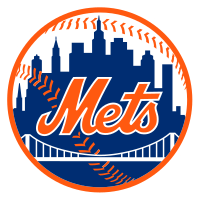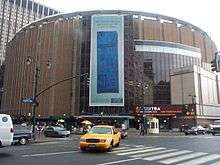New York Mets
The New York Mets are a Major League Baseball team based in the New York City borough of Queens. They compete in Major League Baseball (MLB) as a member club of the National League (NL) East division. They are one of two MLB teams based in New York City, the other being the New York Yankees of the American League (AL).
| New York Mets | |||||
|---|---|---|---|---|---|
| Established in 1962 | |||||
| |||||
| Major league affiliations | |||||
| |||||
| Current uniform | |||||
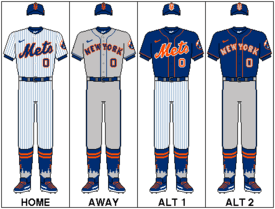 | |||||
| Retired numbers | |||||
| Colors | |||||
| Name | |||||
| |||||
| Other nicknames | |||||
| Ballpark | |||||
| |||||
| Major league titles | |||||
| World Series titles (2) | |||||
| NL Pennants (5) | |||||
| East Division titles (6) | |||||
| Wild card berths (3) | |||||
| Front office | |||||
| Principal owner(s) | Fred Wilpon (52%) Several others (48%) | ||||
| Manager | Luis Rojas | ||||
| General manager | Brodie Van Wagenen | ||||
| President of baseball operations | Saul Katz | ||||
One of baseball's first expansion teams, the Mets were founded in 1962 to replace New York's departed NL teams, the Brooklyn Dodgers and the New York Giants. The team's colors combine the Dodgers' blue and the Giants' orange.[1] For the 1962 and 1963 seasons, the Mets played home games at the Polo Grounds in Manhattan before eventually making the move to Queens. From 1964 to 2008, the Mets played their home games at Shea Stadium, named after William Shea - the founder of the Continental League which was instrumental in bringing NL baseball back to New York. Since 2009, the Mets have played their home games at Citi Field next to the site where Shea Stadium once stood.
In their inaugural season, the Mets posted a record of 40–120, the worst regular season record since MLB went to a 162-game schedule. The team never finished better than second-to-last until the "Miracle Mets" beat the Baltimore Orioles in the 1969 World Series, which was considered one of the biggest upsets in World Series history.[6] Overall, the Mets have qualified for the postseason on nine occasions, winning the World Series twice (1969 and 1986) and the National League pennant five times.
Since 1986, the Mets have, at least in part, been owned by real estate developer Fred Wilpon, who became the majority owner in 2002.[7] In 2019, Forbes ranked the Mets as the 38th most valuable sports team in the world and sixth-most in MLB.[8]
At the end of the 2019 season, the team's overall win-loss record was 4,448–4,808, a .481 win percentage.[9]
Franchise history

After the 1957 season, the Brooklyn Dodgers and New York Giants relocated from New York to California to become the Los Angeles Dodgers and San Francisco Giants, leaving the largest city in the United States with no National League franchise and only one major league team, the New York Yankees of the American League (AL). With the threat of a New York team joining a new third league, the National League expanded by adding the New York Mets following a proposal from William Shea. In a symbolic reference to New York's earlier National League teams, the new team took as its primary colors the blue of the Dodgers and the orange of the Giants, both of which are colors also featured on the Flag of New York City. The nickname "Mets" was adopted: it was a natural shorthand to the club's corporate name, "The New York Metropolitan Baseball Club, Inc.",[10] hearkened back to the "Metropolitans" (a former New York team in the American Association from 1880 to 1887),[1] and its brevity was advantageous for newspaper headlines.[11]
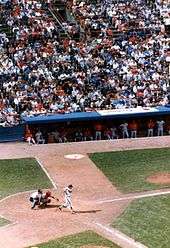
For the first two years of its existence, the team played its home games at the historic Polo Grounds in Upper Manhattan. In 1964, they moved into newly constructed Shea Stadium in Flushing, Queens, where the Mets played until the 2008 season. In 2009, the club moved into Citi Field, adjacent to the former Shea Stadium site.
During their history, the Mets have won two World Series titles (1969 and 1986), five National League pennants (1969, 1973, 1986, 2000, 2015) and six National League East titles (1969, 1973, 1986, 1988, 2006, 2015). The Mets also qualified for the postseason as the National League wild card team in 1999, 2000, and 2016. The Mets have appeared in five World Series, more than any other expansion team in MLB history. Their two championships are the most titles among expansion teams, equal to the tallies of the Toronto Blue Jays, Miami Marlins, and Kansas City Royals.[12]
The Mets held the New York baseball single-season attendance record for 29 years. They broke the Yankees' 1948 record by drawing nearly 2.7 million spectators in 1970. The Mets broke their own record five times before the record was regained by the Yankees in 1999.[13][14]
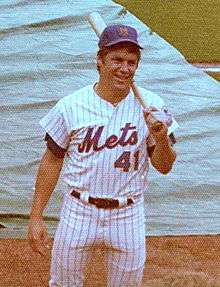
The 1962 Mets posted a 40–120 record, a record for the most losses in a season since 1899. In 1966, the Mets famously bypassed future Hall of Famer Reggie Jackson in the amateur draft, instead selecting Steve Chilcott, who never played in the majors. But the following year, they acquired future Hall of Famer Tom Seaver in a lottery. Seaver helped the 1969 "Miracle Mets" win the new National League East division title, then defeat the Atlanta Braves to win the National League pennant and the heavily favored Baltimore Orioles to win the 1969 World Series.
In 1973, the Mets rallied from 5th place to win the division, despite a record of only 82–79. They shocked the heavily favored Cincinnati Reds "Big Red Machine" in the NLCS and pushed the defending World Series champion Oakland Athletics to a seventh game, but lost the series. Notably, 1973 was the only NL East title between 1970 and 1980 that wasn't won by either the Philadelphia Phillies or the Pittsburgh Pirates.[15][16]
Star pitcher Tom Seaver was traded in 1977, on a day remembered as "the Midnight Massacre",[17] and the Mets fell into last place for several years. The franchise turned around in the mid-1980s. During this time the Mets also drafted slugger Darryl Strawberry (#1 in 1980) and 1985 Cy Young Award winner Dwight Gooden (#5 in 1982). In addition, former National League MVP and perennial Gold Glove winner Keith Hernandez was obtained by the Mets in 1983.
In 1985, they acquired Hall of Fame catcher Gary Carter from the Montreal Expos and won 98 games, but narrowly missed the playoffs. In 1986, they won the division with a record of 108–54, one of the best in National League history. They won a dramatic NLCS in six games over the Houston Astros. The sixth game of the series went sixteen innings, the longest playoff game in history until 2005. They came within one strike of losing the World Series against the Boston Red Sox before a series of hits and defensive miscues ultimately led to an error by Boston's Bill Buckner which gave the Mets a game 6 victory. They then won Game 7 to win their second World Series title.
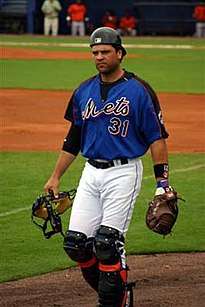
The Mets continued playing well after 1986 and won the division in 1988, but lost in the NLCS that year and declined into the 1990s. They were out of contention until the 1997 season when they were in wild card contention until the final week of the season. In 1998, the Mets acquired catcher Mike Piazza in a blockbuster trade and missed the postseason by only one game. In 1999, they made the playoffs after a one-game playoff, but lost the 1999 National League Championship Series to the Atlanta Braves. In 2000, they easily clinched a wild card spot in the playoffs, and earned a trip to the 2000 World Series against their crosstown rivals, the New York Yankees for a "Subway Series". The Mets were defeated by the Yankees in five games.
The Mets had a near playoff miss in 2001 and struggled from 2002 to 2004. In the aftermath of the 2004 season, the Mets hired a new general manager, Omar Minaya, who immediately turned the franchise around by signing pitcher Pedro Martínez and hiring a new manager, Willie Randolph. The Mets finished 2005 four games over .500, and the franchise's resurgence was complete by 2006 as they won 97 games and the NL East title behind new acquisitions Carlos Beltrán and Carlos Delgado, as well as young superstars José Reyes and David Wright. The Mets advanced to game seven of the 2006 NLCS but lost after Yadier Molina's game-winning two-run home run in the top of the ninth inning. The Mets loaded the bases with two outs in the bottom of the inning, but Adam Wainwright struck out Beltran looking with a devastating curveball.
In 2007, the Mets entered the final 17 games in the season with a seven-game lead in the division. But the team went on an ill-timed losing streak, losing 11 of the next 15 games and needing to win their final two games to make the playoffs. The Mets won their penultimate game, but on the final day of the season, Tom Glavine gave up seven runs in the first inning en route to an 8–1 loss that eliminated the team from contention. The Philadelphia Phillies won the division by one game after a win on the season's last day.
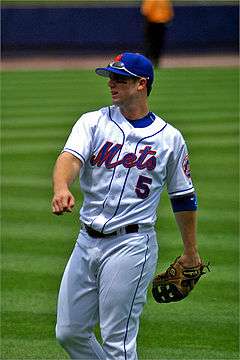
The Mets held a more modest 3.5-game lead after 145 games of the 2008 season, their final season at Shea Stadium. While their 7–10 mark down the stretch was better than the previous season's 5–12, it still allowed the Phillies to pass them once again for the division crown, which they lost by three games. The Mets opened Citi Field in 2009, but were not a factor due to a rash of injuries to numerous key players including Reyes, Carlos Beltrán, Carlos Delgado, Óliver Pérez and Liván Hernández. The effect of the injuries plummeted the Mets to a 70–92 record. The Mets improved to a 79–83 in 2010, but still finished in fourth place, missing the playoffs for the fourth straight year.
After the 2010 season, the Mets fired Minaya and manager Jerry Manuel. Former Oakland Athletics G.M. and MLB executive Sandy Alderson was hired to run the team, who hired Terry Collins as manager.
In 2012, Mets owners Fred Wilpon and Saul Katz settled a lawsuit brought against them on behalf of the victims of Bernard Madoff's Ponzi scheme for $162 million. As a result of this agreement the liquidator, Irving Picard, agreed to drop the charges that Wilpon and Katz blindly went along with the scheme for their personal benefit. Picard had originally sought to recover $1 billion from the Wilpon family and Katz, but settled for $162 million along with the admission that neither the Wilpons nor Katz had any knowledge of the Ponzi scheme. In 2011–2012, Mets ownership sold twelve minority 4% shares (48%) of the franchise at $20 million apiece to provide a cash infusion of $240 million for the team.[18]
Despite yet another losing season, the Mets made history in 2011 when closer Jason Isringhausen converted his 300th save with the team, the third player in franchise history to reach the milestone while with the organization (after John Franco and Billy Wagner). Also, Reyes became the first Met in franchise history to win a National League batting title, posting a .337 batting average. In 2012, as the Mets tried to bounce back from three consecutive losing seasons, they lost star shortstop Reyes to free agency, when he signed with the Miami Marlins. The team started out strong, getting a career-year performance from the league's only knuckleballer, R.A. Dickey, and strong production from Wright. But they faltered midseason and ended with a 74–88 record, again finishing fourth in the division.
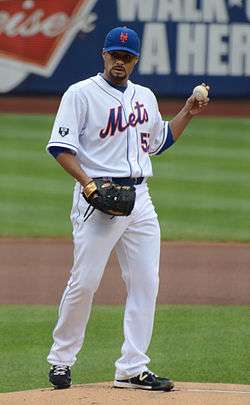
Prior to the 2012 season the Mets had yet to throw a no-hitter, and the franchise's hurlers had gone 8,019[19] games without pitching one – longer than any other major-league franchise. They were one of only two major-league teams to never have a pitcher throw a no-hitter (the other being the San Diego Padres). However, on June 1, 2012 Johan Santana pitched a no-hitter against the St. Louis Cardinals. Averting the spotlight from Carlos Beltrán's return to Citi Field, Santana turned a routine game into a memorable moment in Mets history. Santana risked being removed from the game after he went over his limit of 110 pitches, placed by the team because of his shoulder surgery. Still Santana stayed in the game and threw 134 total pitches that evening in an 8–0 Mets victory, helped by a few great defensive plays as well as a controversial foul-ball call (coincidentally on Beltran), to pull off the first no-hitter in Mets history.[20] That was the high point of 2012 along with pitcher R.A. Dickey winning the National League Cy Young Award. This would be Dickey's final season with the Mets, though, as he along with Josh Thole and Mike Nickeas were traded to the Toronto Blue Jays for prospects Travis d'Arnaud, Noah Syndergaard, Wuilmer Becerra, and veteran catcher John Buck. The 2013 season brought another 74–88 finish but they were able to finish in 3rd place. The highlight of the season was sweeping the season series between their cross town rivals Yankees, a first since interleague play started in 1997.

Prior to the start of the 2014 season the Mets made a big splash in the free agent market by signing former New York Yankees outfielder Curtis Granderson to a 4-year $60 million contract. They also signed former Oakland Athletics starting pitcher Bartolo Colón to a 2-year deal to help offset losing ace pitcher Matt Harvey for the year after he required Tommy John surgery. They would improve to 79–83 and finish the season tied for 2nd place with Atlanta but it was their 6th consecutive season where they finished under .500. Pitcher Jacob deGrom would win the National League Rookie of the Year.[21]
On April 23, 2015 the Mets tied a franchise season record of eleven straight wins. For the first time in its history the Mets won ten straight homestand games, becoming the 7th team since 1900 to win at least 10 straight homestand games.[22] On September 26, 2015, the Mets clinched the NL East division title, and thus their first postseason berth since 2006, by defeating the Cincinnati Reds 10–2. They defeated the Los Angeles Dodgers in the NLDS, three games to two, and swept the Chicago Cubs in the NLCS for their first pennant in 15 years. In the 2015 World Series, they were defeated by the Kansas City Royals in five games. After the season ended, pitcher Matt Harvey won the NL Comeback Player of the Year award. Outfielder Yoenis Céspedes won the NL Gold Glove award as a left fielder.
The Mets returned to the postseason in 2016, marking only the second time in franchise history that the team qualified for the postseason in consecutive years. With a 87-75 record, the team qualified for the wild-card game, only to lose 3-0 to the San Francisco Giants. That year, Céspedes would be awarded with a Silver Slugger Award and outfielder, Curtis Granderson, was honoured with the Roberto Clemente Award. The Mets failed to make the playoffs for the rest of the decade, finishing no higher than third place in 2019 when they finished with a winning record of 86-76 (the highest of any team not to qualify for the postseason).[23] The end of the decade also coincided with Jacob deGrom being awarded two consecutive Cy Young Awards (including for the 2018 season when the pitcher finished the year with 1.70 ERA)[24] and first-baseman, Pete Alonso, winning the 2019 Rookie of the Year and finishing the season with a major-league-leading 53 home runs - the most out of any rookie in MLB history.[25]
Theme song
"Meet the Mets" is the Mets' signature song, written in 1961, one year before the first season, by Bill Katz and Ruth Roberts. It is played on the radio, during television broadcasts and at Mets' home games.[26]
Mascot
Mr. Met is the official mascot of the New York Mets. He was introduced on the cover of game programs in 1963, when the Mets were still playing at the Polo Grounds in northern Manhattan.[27] When the Mets moved to Shea Stadium in 1964, fans were introduced to a live costumed version.[27] Mr. Met is believed to have been the first mascot in Major League Baseball to exist in human (as opposed to artistically rendered) form.[27]
Mrs. Met (formerly Lady Met) is the female counterpart to Mr. Met, and the couple sometimes appears with 2–3 smaller "children".[28]
The Mets have had two mascots other than Mr. and Mrs. Met at different points in its history. The franchise's original official mascot was Homer, a beagle trained by Rudd Weatherwax that lived at the Waldorf-Astoria, was sponsored by Rheingold Beer and had his own platform behind home plate at the Polo Grounds. The dog was not included in the ballclub's transition to Shea Stadium.[29][30] The brainchild of team owner Lorinda de Roulet's daughter Bebe, Mettle the mule represented the Mets for only the 1979 season. The name was the result of a contest won by Dolores Mapps of Mercerville, New Jersey whose explanation was that it typified the team's “spirit, ardor, stamina and courage, all of which the Mets have in abundance.” Mettle was not retained after the franchise was sold to Nelson Doubleday and Fred Wilpon the following year.[31]
Uniform and logo symbolism

The Mets' colors are blue and orange, originally chosen to honor the city's history of National League baseball; blue for the Brooklyn Dodgers, and orange for the New York Giants. Blue and orange are also the colors of New York City, as seen on its flag.[1]
In 1998, black was officially added to the color scheme, although beginning with 2012 the black elements in the uniform began to be phased out, and were completely eliminated in 2013.
Logo
The primary logo, designed by sports cartoonist Ray Gotto, consists of "Mets" written in orange script trimmed in white across a blue representation of the New York City skyline with a white suspension bridge in the foreground, all contained in an orange circle with orange baseball stitching across the image. Each part of the skyline has special meaning—at the left is a church spire, symbolic of Brooklyn, the borough of churches; the second building from the left is the Williamsburgh Savings Bank Building, the tallest building in Brooklyn at the time of the team's founding; next is the Woolworth Building; after a general skyline view of midtown comes the Empire State Building; at the far right is the headquarters of the United Nations. The suspension bridge in the center symbolizes that the Mets, by bringing National League baseball back to New York, represent all five boroughs; many of New York's major bridges are suspension designs.[1] In 1999, the logo received a slight alteration; a small "NY" originally placed to the left of the team script was removed. No other notable changes have ever been made to the logo.
The cap logo consists of an orange, interlocking "NY" identical to the logo used by the New York Giants in their final years, and is on a blue cap reminiscent of the caps worn by the Brooklyn Dodgers.
With the introduction of black as an official color, an alternate team logo was created in 1999. It is identical to the original logo, but the skyline is black instead of blue and the "Mets" script is blue trimmed in orange and white instead of orange trimmed in white (the alternate black jerseys displayed the primary blue and orange logo on the left sleeves in 1998; in 1999 this was changed to the alternate black and blue logo). The logo fell into disuse after the Mets dropped the alternate black jerseys and caps in 2012.
Uniform color and design
Currently, the Mets wear an assortment of uniforms.
The home uniforms are white with blue pinstripes, and feature the "Mets" script and block lettering and numbers in blue with orange outline. The uniforms are paired with a standard blue cap featuring the "NY" script in orange, plus blue undersleeves, belts and socks. The white pinstriped uniforms replaced both the cream pinstriped uniform and the alternate white uniform starting with the 2015 season.
The gray road jerseys feature a radially-arched "NEW YORK" script in Tiffany style, player numerals and names in blue outlined in orange, and blue placket and sleeve piping. Like the home uniforms, the road grays are worn with blue caps, undersleeves, belts and socks.
On November 14, 2012, the Mets introduced two new blue alternate jerseys. The home alternate features the "Mets" script, player numerals and names in orange outlined in white, while the road alternate feature the "NEW YORK" script, player numerals and names in gray outlined in orange.[32]
On December 10, 2012, the Mets unveiled an alternate blue fielding cap, featuring an orange brim and a white trim around the orange "NY" insignia.[33] Currently it is only worn in games featuring the home blue alternates. For 2015, another alternate blue cap, this time featuring the "NY" in gray outlined in orange, was introduced, and is paired with the road blue alternates. In 2017, the alternate home blue cap was modified to feature a blue brim.
For the 2014 season, a Mr. Met sleeve patch was added to the blue alternate jerseys,[34] a feature that was later removed in favor of the primary logo in 2017.
The Mets' standard blue batting helmet, with the "NY" in orange, is currently used regardless of the cap and jersey design they wear. This was in contrast to previous seasons, where they played with alternate batting helmets to match their caps and jerseys.
Players of note
Team captains
Four players have been team captains for the Mets:
- Keith Hernandez 1987–1989 (co-captain with Gary Carter)[35][36]
- Gary Carter 1988–1989 (co-captain with Keith Hernandez)[35][36]
- John Franco 2001–2004[35][36]
- David Wright 2013–2018[35][36]
Baseball Hall of Famers

| New York Mets Hall of Famers | |||||||||
|---|---|---|---|---|---|---|---|---|---|
| Affiliation according to the National Baseball Hall of Fame and Museum | |||||||||
|
| New York Mets Ford C. Frick Award recipients | |||||||||
|---|---|---|---|---|---|---|---|---|---|
| Affiliation according to the National Baseball Hall of Fame and Museum | |||||||||
|
Retired numbers
Ralph Kiner Broadcaster Honored March 31, 2014 |
 Gil Hodges* 1B Manager Retired June 9, 1973 |
 Mike Piazza* C Retired July 30, 2016 |
 Casey Stengel Manager Retired September 2, 1965 |
 Tom Seaver* P Retired July 24, 1988 |
 Jackie Robinson All MLB Retired April 15, 1997 |
 William A. Shea Proponent Honored April 8, 2008 |

Major League Baseball retired Jackie Robinson's number 42 on April 15, 1997, when the Mets played the Dodgers at Shea Stadium. Butch Huskey wore the number throughout the rest of his Mets career because of a grandfather clause placed on the retired number by MLB.[38] Mo Vaughn also wore 42 during his stint with the Mets, because of the same clause.[38]
On the final opening day at Shea Stadium, April 8, 2008, the Mets unveiled a sign bearing the name "Shea" next to the team's retired numbers honoring William Shea and his contributions to the franchise.[39]
In 2014, a special memorial logo honoring broadcaster Ralph Kiner, depicting a microphone along with his name and the years 1922–2014, was displayed on the left field wall adjacent to, but not as a part of, the Mets' retired numbers, from 2014 to 2016. In the 2016 Mets yearbook, a sidebar in an article on Mike Piazza's upcoming number retirement implies that Kiner has been "retired" a la William A. Shea.[40] This was confirmed when the Mets' retired numbers were moved to the roof facade during the 2016 season to accommodate Mike Piazza's #31; the Kiner logo was placed next to the Shea and Jackie Robinson numbers, no longer separated from the others.
The New York Mets announced that they will retire Jerry Koosman's #36 on June 13, 2020, making him only the third former Mets player to have their number retired in honor of his playing career.[41]
Numbers out of circulation but not retired
- 5: Not issued since the retirement of David Wright.
- 8: Not issued since Gary Carter was elected to the Hall of Fame in 2003.[42] When the Mets honored Carter, they did not retire number 8, but instead gave him a replica of his Hall of Fame plaque depicting him as a Met instead of an Expo. Desi Relaford was the last Mets player to wear No. 8; Matt Galante, a coach, later wore the number. After Carter's death, the Mets honored him in a ceremony on opening day 2012, where they unveiled the "Kid 8" memorial logo (also worn on the uniform sleeve) on the outfield fence. However, the number 8 is still not officially retired.[43]
- 17: Since Keith Hernandez's retirement, his number 17 has been worn by numerous players including David Cone, Jeff McKnight, Bret Saberhagen, Luis López, Mike Bordick, Kevin Appier, Dae-Sung Koo, José Lima, David Newhan, and lastly by Fernando Tatís, who played for the Mets from 2008 to 2010. It has not been re-issued to any player or coach since 2010.[44]
Numbers restored to circulation
- 24: After the retirement of Willie Mays, then-owner Joan Whitney Payson had promised it would not be issued again. The number was given to first baseman-outfielder Kelvin Torve in 1990, by mistake. The number was later issued to Rickey Henderson in 1999–2000 as a player and again in 2007 as a coach.[42][45] The number 24 was brought back into circulation in 2019 when Robinson Cano, who wore it with the Yankees to honor Jackie Robinson, was traded to the Mets.[46]
Rivalries
Subway Series: New York Yankees
The Mets – New York Yankees rivalry is the latest incarnation of the Subway Series, the competition between New York City's teams, the American League New York Yankees and the National League Mets. Until Interleague play started, the two teams had only met in exhibition games. Since the inception of interleague play the two teams have met every regular season since 1997, and since 1999 they have met six times each season, playing two three-game series, one in each team's ballpark. From the 2013 season however the number of games was reduced to four, two at each ballpark with the Mets winning six of the last eight games in that span. They have made the postseason in the same year four times: 1999, 2000, 2006, and 2015, and faced off in the 2000 World Series.
Atlanta Braves
The Braves–Mets rivalry is a rivalry between two teams in the National League East, featuring the Atlanta Braves and the Mets.[47]
Although their first major confrontation occurred when the Mets swept the Braves in the 1969 NLCS, en route to their first World Series championship, the first playoff series won by an expansion team (also the first playoff appearance by an expansion team), the rivalry did not become especially heated until the 1990s, when a division realignment in 1994 put the Mets and the Braves in the NL East together (from 1969 to 1993, the Braves were in the NL West).[48][49] The two teams faced each other again in the 1999 NLCS, and the Braves won the series four games to two. However, they would go on to lose to the Yankees in the 1999 World Series.
Philadelphia Phillies
The rivalry between the Mets and the Philadelphia Phillies from 2006 to 2008 was said to be among the "hottest" rivalries in the National League.[50][51]
Aside from several brawls in the 1980s, the rivalry remained low-key before the 2006 season,[52] as the teams had seldom been equally good at the same time. Since 2006, the teams have battled for playoff position. The Mets won the division in 2006 and contended in 2007 and 2008, while the Phillies won five consecutive division titles from 2007 to 2011.[53] The Phillies' 2007 Eastern Division Title was won on the last day of the season as the Mets lost a seven-game lead with 17 games remaining while losing 12 of 18 games that season to the Phillies, including being swept at home in the first 3 games of the remaining 17, dropping their lead from 7 games to 3.5.
Staff
| New York Mets staff |
|---|
Office of the Chairman
Front Office
Coordinators
|
Roster
New York Mets roster | ||||||
|---|---|---|---|---|---|---|
| Active roster | Player pool | Coaches/Other | ||||
|
Pitchers
Bullpen
Closer
|
Catchers
Infielders
Outfielders
|
Pitchers
Catchers
Infielders
Outfielders
|
Manager
Coaches
45-day injured list
Restricted list 28 active, 31 player pool
| |||
New York Mets Foundation
A registered 501(c)(3) charity, the New York Mets Foundation is the philanthropic organization of the New York Mets. Founded in 1963, it funds and promotes charitable causes in the Mets community. One of these causes is Tuesday's Children, is a non-profit family service organization that "has made a long term commitment to meet the needs of every family who lost a loved one in the terrorist attacks on September 11, 2001".[54] The Mets host the annual Welcome Home Dinner, which raised over $550,000 for the Mets Foundation in 2012. All proceeds were distributed to Katz Institute for Women's Health and Katz Women's Hospitals of North Shore-LIJ Health System and The Leukemia & Lymphoma Society.
Owners and executives
New York Mets broadcasters
Television
Most Mets games are carried by SportsNet New York (SNY), a joint venture of the Mets and NBC Sports Regional Networks. The team's terrestrial broadcast home is WPIX, where the team has broadcast games since 1999.
Longtime Mets radio announcer Gary Cohen does the play-by-play, having moved to television with the launch of SNY in 2006. Former Mets Keith Hernandez and Ron Darling are the color commentators with Steve Gelbs being the on the field reporter.
In early January 2016, Keith Hernandez re-signed with SNY. Reports indicate that Hernandez received a raise and three-year contract.[55]
Radio
Beginning in 2019, Mets games are broadcast on WCBS-AM 880.[56] Howie Rose is the main play-by-play announcer; Josh Lewin, his broadcast partner since 2012, will not return.[57] Wayne Randazzo, who previously hosted the pre- and post-game shows, will replace Lewin; longtime Mets beat reporter Ed Coleman will take over the pre- and post-game role for most games.[58]
The Mets' previous radio flagship was WOR-AM,[59] from 2014 to 2018.[60] The Mets were previously carried by WFAN-AM, which inherited the team's broadcast rights from WHN when it took over its frequency in 1987, and in later years by WFAN-FM which simulcasts the AM signal.
Spanish-language broadcasts are carried by WEPN-AM 1050, ESPN Deportes Nueva York, featuring Juan Alicea and Max Perez-Jimenez.[61]
Rose, who has spent much of his career covering the Mets, replaced Bob Murphy as Gary Cohen's broadcast partner in 2004 following Murphy's retirement. Cohen then left the radio booth for the SNY television booth in 2006 and was replaced by Tom McCarthy, who departed after two seasons and was replaced by Wayne Hagin. Lewin joined the broadcast after the team parted ways with Hagin following the 2011 season.
Coinciding with the move to WCBS, the Mets, abruptly and without public announcement (other than a brief e-mail to its affiliates days before the season began), stopped syndicating its games to other stations outside the New York City area, shutting down the New York Mets Radio Network.[62][63]
Minor league affiliations
The New York Mets farm system consists of nine minor league affiliates.[64]
| Level | Team | League | Location |
|---|---|---|---|
| Triple-A | Syracuse Mets | International League | Syracuse, New York |
| Double-A | Binghamton Rumble Ponies | Eastern League | Binghamton, New York |
| Class A-Advanced | St. Lucie Mets | Florida State League | Port St. Lucie, Florida |
| Class A | Columbia Fireflies | South Atlantic League | Columbia, South Carolina |
| Class A Short Season | Brooklyn Cyclones | New York–Penn League | Brooklyn, New York |
| Rookie | Kingsport Mets | Appalachian League | Kingsport, Tennessee |
| GCL Mets | Gulf Coast League | Port St. Lucie, Florida | |
| DSL Mets 1 | Dominican Summer League | Boca Chica, Santo Domingo | |
| DSL Mets 2 |
See also
References
- "Mets Franchise Timeline: 1960s". Mets.com. MLB Advanced Media. Retrieved April 18, 2018.
- "Cap And Uniform History" (PDF). 2020 New York Mets Media Guide. MLB Advanced Media. Retrieved February 27, 2020.
- Golenbock, Peter, ed. (2002). Amazin': The Miraculous History of New York's Most Beloved Baseball Team. Macmillan. p. 108. ISBN 0312309929. Retrieved October 24, 2015.
- Blum, Ronald, ed. (October 22, 2015). "Mets' return to World Series evokes legends of star-studded teams from the past". Washington Post. Retrieved October 24, 2015.
- Worth, Richard, ed. (2013). Baseball Team Names: A Worldwide Dictionary, 1869–2011. pp. 201–208, 361, 368. ISBN 9780786468447. Retrieved October 25, 2015.
- "Greatest Upsets In Sports History". Sports Illustrated. Retrieved October 25, 2015.
- "The Wilpons' worst and best moments as Mets owners". NY Post. December 5, 2019. Retrieved July 8, 2020.
- "The World's 50 Most Valuable Sports Teams 2019". Forbes. July 22, 2019. Retrieved July 8, 2020.
- "New York Mets Team History & Encyclopedia". Baseball Info Solutions. Retrieved October 1, 2018.
- "The New York Metropolitan Baseball Club, Inc". Bloomberg LP. Retrieved February 8, 2017.
- Effrat, Louis (May 9, 1961). "New National League Team Here Approves Mets as Its Official Nickname". New York Times. p. 48.
- Dodd, Mike (April 11, 2011). "MLB expansion effects still felt 50 years later around the leagues". USA Today. Retrieved March 6, 2015.
Despite a record 120 losses in their debut season, the New York Mets can make a case as the most successful expansion franchise, with four pennants and two World Series titles. None of the others has more than two league titles, though the Toronto Blue Jays and Florida Marlins each won two world championships in significantly fewer years.
- "New York Mets attendance". Baseball Reference. Retrieved August 7, 2010.
- "New York Yankees attendance". Baseball Reference. Retrieved August 7, 2010.
- Von Benko, George (July 7, 2005). "Notes: Phils–Pirates rivalry fading". Philadelphia Phillies. MLB. Archived from the original on July 14, 2011. Retrieved January 3, 2011.
From 1974–80, the Phillies and Pirates won all seven National League East titles (Phillies four, Pirates three).
- "Pirates perform rare three-peat feat 4–2". USA Today. September 28, 1992. p. 5C.
The Pirates...won three (NL East titles) in a row from 1970–72.
- Madden, Bill (June 17, 2007). "The true story of The Midnight Masscare". New York Daily News. Archived from the original on October 9, 2017. Retrieved September 28, 2014.
- "New York Mets settle with Madoff trustee for $162 million – ESPN New York". ESPN.com. Retrieved October 4, 2014.
- "Johan Santana tosses no-hitter". ESPN.com. Retrieved October 4, 2014.
- "Santana pitches first no-hitter in Mets' history". CBS News. Retrieved June 2, 2012.
- "2014 MLB Rookie of the Year – Jacob deGrom of New York Mets named NL winner". ESPN.com. November 11, 2014. Retrieved August 20, 2015.
- Pelzman, JP. Mets equal franchise record with 11th straight victory. The Record April 23, 2015 http://www.northjersey.com/sports/mets-equal-franchise-record-with-11th-straight-victory-1.1316609 Accessed April 29, 2015
- "2019 Major League Baseball Standings and Expanded Standings". baseball-reference.com. October 31, 2019. Retrieved July 7, 2020.
- "Jacob deGrom Wins Second Straight Cy Young Award". NY Times. November 13, 2019. Retrieved July 7, 2020.
- "Pete Alonso Becomes the 6th Met to Be Named Rookie of the Year". NY Times. November 11, 2019. Retrieved July 7, 2020.
- Keepnews, Peter (July 4, 2011). [https://www.webcitation.org/600TcwGbx?url=http://www.nytimes.com/2011/07/05/arts/music/ruth-roberts-meet-the-mets-songwriter-dies-at-84.html?_r=1&&&>+Sports)&seid=auto&smid=tw-nytimessports "Ruth Roberts, 'Meet the Mets' Songwriter, Dies at 84"]. The New York Times. Archived from the original on July 7, 2011. Retrieved July 7, 2011.
- McGuire, Stephen; Liz Goff (April 25, 2002). "He's In The Army Now: The Life And Times Of Mr. Met". Queens Tribune. Archived from the original on June 15, 2011. Retrieved October 4, 2009.
- Chandler, Rick, ed. (July 5, 2013). "Mrs. Met Is Back, And Apparently She's Into Some Pretty Kinky Stuff". Sports Grid. Retrieved October 24, 2015.
- Rushin, Steve. "Bad Beyond Belief," Sports Illustrated, May 25, 1992. Retrieved September 4, 2019
- Silverman, Matthew. New York Mets: The Complete Illustrated History. Minneapolis, MN: MVP Books, 2011. Retrieved September 4, 2019
- Belson, Ken. "When the Mets Had Mettle," The New York Times, Friday, February 26, 2010. Retrieved September 4, 2019
- "NY Mets Show Off Two New Blue Alternate Jerseys | Chris Creamer's SportsLogos.Net News and Blog : New Logos and New Uniforms news, photos, and rumours". News.sportslogos.net. Retrieved January 27, 2013.
- "New York Mets Unveil New Alt Cap at Press Conference | Chris Creamer's SportsLogos.Net News and Blog : New Logos and New Uniforms news, photos, and rumours". News.sportslogos.net. Retrieved January 27, 2013.
- Chris Creamer (December 20, 2013). "Mr. Met added to New York Mets 2014 Uniforms". News.sportslogos.net. Retrieved April 14, 2014.
- DiComo, Anthony, ed. (March 21, 2013). "Wright appointed fourth captain in Mets history". MLB. Retrieved October 25, 2015.
- "Mets captains through the years". newday.com. Newsday. March 21, 2013. Retrieved July 24, 2019.
- Dubow, Josh (January 16, 2003). "Carter to go into Hall of Fame with Expos hat". USA Today. Archived from the original on May 13, 2011. Retrieved June 4, 2011.
- Smith, Claire (April 16, 1997). "A Grand Tribute to Robinson and His Moment". The New York Times. Archived from the original on December 3, 2011. Retrieved June 4, 2011.
- DiComo, Anthony (April 3, 2008). "Shea family to be honored at home". New York Mets. Archived from the original on October 9, 2012. Retrieved June 4, 2011. Cite journal requires
|journal=(help) - 2016 New York Mets Yearbook, page 62,
- @AnthonyDiComo (September 24, 2019). "Some news: The Mets are going to retire Jerry Koosman's uniform number 36 next year" (Tweet) – via Twitter.
- "Mets by the Numbers". Archived from the original on October 4, 2006. Retrieved July 26, 2006.
- "Mets honor Carter's Memory". ESPN.
- Vaccaro, Mike (January 25, 2016). "The next four numbers Mets must retire after Piazza". New York Post. Retrieved October 3, 2017.
- Noble, Marty (April 17, 2015). "Mets starting to form 2015 identity". MLB.com. Retrieved May 20, 2015.
- DiComo, Anthony (December 4, 2018). "New Mets Cano, Diaz introduced at Citi Field". MLB.com. Retrieved December 5, 2018.
- Olson, Lisa (July 8, 2003). "Crazy scene at Shea takes luster off Mets-Braves rivalry". New York Daily News. Archived from the original on June 13, 2018. Retrieved July 23, 2018.
- Bodley, Hal (September 16, 1993). "Pirates OK new realignment". USA Today. p. 1C.
The Pirates will switch from the East next season. They opposed the move last week when realignment was approved, but agreed to allow Atlanta to move to the East.
- Chass, Murray (September 16, 1993). "Pirates Relent on New Alignment". New York Times. p. B14.
- Bondy, Filip (April 11, 2008). "Mets-Phillies rivalry looking like what Mets-Braves used to be". New York Daily News. Archived from the original on March 22, 2018. Retrieved June 15, 2009.
- Westcott, Rich (2010). Philadelphia Phillies Past & Present. MVP Books. p. 10. ISBN 9780760337844. Retrieved July 15, 2011.
- Bondy, Filip (May 24, 2006). "Despite long game, rivalry long way off". New York Daily News. Archived from the original on July 23, 2018. Retrieved January 11, 2010.
- Radano, Mike (September 17, 2011). "High Phive: Phils clinch fifth straight East title". Philadelphia Phillies. MLB. Retrieved September 18, 2011.
- Brown, Phil. "Mets, Who We Are".
- "Keith Hernandez to return to SNY". SNY. Retrieved February 3, 2016.
- Entercom Communications (September 17, 2018), WCBS 880 To Be Mets' New Flagship Radio Home, WFAN Sports Radio, retrieved January 2, 2019
- Wayne Randazzo Likely Headed to Mets' Radio Booth, BSM Sports Media, December 4, 2018, retrieved January 1, 2019
- Marchand, Andrew (January 2, 2019), The new Mets booth will start on a short leash, New York Post, retrieved January 2, 2019
- "The Mets Find New Home at WOR". Archived from the original on May 27, 2016. Retrieved November 5, 2013.
- Everett, Seth (September 18, 2018), "New York Mets Move Radio Broadcasts To WCBS/Entercom", Forbes, retrieved January 1, 2019
- Mets Radio & TV Coverage, New York Mets, retrieved January 2, 2019
- Mets abandon upstate radio network for 2019 season from the Times-Union of Albany, NY; April 1, 2019
- New York Mets radio blackout a ‘middle finger’ to CNY fans, CEO says, from The Post-Standard of Syracuse, NY (April 1, 2019)
- "New York Mets Minor League Affiliates". Baseball-Reference. Sports Reference. Retrieved May 15, 2020.
External links
| Wikimedia Commons has media related to New York Mets. |
| Wikiquote has quotations related to: New York Mets |
- New York Mets official website
- History of the New York Mets
- New York Mets Team Index
- Ultimate Mets Database
| Achievements | ||
|---|---|---|
| Preceded by Detroit Tigers 1968 |
World Series champions New York Mets 1969 |
Succeeded by Baltimore Orioles 1970 |
| Preceded by Kansas City Royals 1985 |
World Series champions New York Mets 1986 |
Succeeded by Minnesota Twins 1987 |
| Preceded by St. Louis Cardinals 1967 and 1968 |
National League champions New York Mets 1969 |
Succeeded by Cincinnati Reds 1970 |
| Preceded by Cincinnati Reds 1972 |
National League champions New York Mets 1973 |
Succeeded by Los Angeles Dodgers 1974 |
| Preceded by St. Louis Cardinals 1985 |
National League champions New York Mets 1986 |
Succeeded by St. Louis Cardinals 1987 |
| Preceded by Atlanta Braves 1999 |
National League champions New York Mets 2000 |
Succeeded by Arizona Diamondbacks 2001 |
| Preceded by San Francisco Giants 2014 |
National League champions New York Mets 2015 |
Succeeded by Chicago Cubs 2016 |
